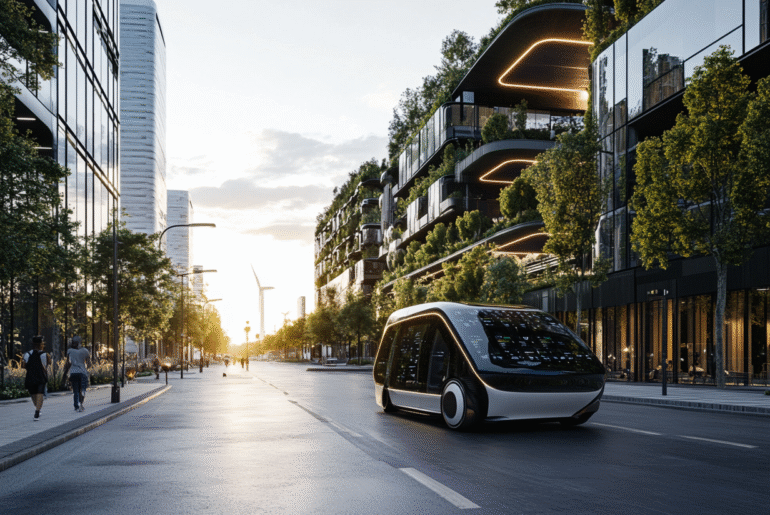This article may contain references to products or services from one or more of our advertisers or partners. We may receive compensation when you click on links to those products or services. Nonetheless, our opinions are our own.
- Key Highlights
- Introduction
- Integrating Technology with Green Living
- The Role of AI in Energy-Efficient Homes
- IoT Advancements for Sustainable Urban Living
- Sustainable Technology in Everyday Life
- The Impact of Smart Appliances on Carbon Footprint
- The Advantages of Using Solar-Powered Systems in Homes Today
- Conclusion
- Frequently Asked Questions
- Recommended Reads
Key Highlights
- Smart technologies such as AI and IoT are transforming energy use and promoting efficient living.
- Renewable energy solutions, like solar power, offer eco-friendly alternatives that reduce carbon emissions.
- Everyday sustainable technologies encourage responsible habits and support environmental goals.
- The circular economy is growing by focusing on reducing waste and maximizing product lifespan.
- Digital tools and innovation are merging with sustainability to shape a cleaner future.
Introduction
The combination of innovation and environmental awareness is redefining modern lifestyles. As climate change becomes more visible, integrating sustainability into technology development is essential. Smart homes, energy-efficient systems, and renewable solutions are improving how energy is used and emissions are reduced. Communities embracing these tools are playing a critical role in supporting global sustainability.
Integrating Technology with Green Living
Technology enhances eco-conscious living by offering tools that promote sustainability without sacrificing comfort. Smart homes equipped with automation and AI features allow efficient energy usage and better waste management.
The impact of this movement extends beyond individual households. Entire cities benefit from smart planning initiatives that utilize digital infrastructure to improve energy and transportation systems. These solutions enable cities to manage resources effectively, reduce emissions, and provide higher-quality urban living.
The Role of AI in Energy-Efficient Homes
Artificial intelligence is enabling households to reduce energy consumption while maintaining convenience. Smart thermostats, for example, adjust indoor temperatures based on weather forecasts, improving energy efficiency.
AI systems analyze usage patterns and recommend energy-saving measures. By identifying inefficient habits, these tools guide users toward better consumption behaviors. As Satya Nadella, CEO of Microsoft, noted, “AI helps us manage our limited resources better.”
In addition, AI enables integration with renewable energy systems by adjusting usage according to real-time supply. This minimizes reliance on fossil fuels and supports environmentally responsible living. As the technology advances, AI will become an integral part of sustainable housing.
IoT Advancements for Sustainable Urban Living
The Internet of Things is essential in developing smart, sustainable cities. Connected sensors and devices streamline urban services and optimize resource management.
- IoT-enabled energy grids reduce electricity waste.
- Smart traffic systems ease congestion and cut emissions.
- Intelligent lighting conserves power through adaptive controls.
- Real-time monitoring of water and utility systems enhances conservation.
Furthermore, initiatives such as scooter sharing, electric bike networks, and optimized waste systems are made possible through IoT. These technologies support clean transportation and efficient infrastructure.
Sustainable Technology in Everyday Life
Sustainable technologies are reshaping everyday experiences. These tools reduce energy usage and environmental impact while improving household efficiency and comfort.
- Solar-powered systems and waste management innovations help minimize pollution.
- Smart appliances lower energy demand and carbon footprints.
- Green building materials and water-saving devices promote responsible living.
Communities and businesses are also adopting circular economy models—prioritizing recycling, reuse, and resource optimization. These efforts not only reduce waste but also improve long-term efficiency and durability.
The Impact of Smart Appliances on Carbon Footprint
Smart home devices offer a practical path to environmental responsibility. Designed to minimize energy use and increase automation, these tools make it easier for individuals to adopt eco-friendly lifestyles.
Smart appliances, such as
- Refrigerators
- Washing machines
- Dishwashers
…are equipped with sensors that adjust power consumption based on usage and time-of-day demand.
For example, a smart washing machine can delay its cycle until off-peak hours, reducing both utility costs and strain on the power grid. These appliances work effectively while supporting sustainability.
Many of these devices are also compatible with solar energy systems. This synergy enhances energy efficiency while reducing dependence on non-renewable resources.
The Advantages of Using Solar-Powered Systems in Homes Today
Solar power offers an effective way to reduce carbon emissions and save on energy costs. Homeowners can choose from various systems, including photovoltaic (PV) panels and solar water heaters.
Benefits of Solar-Powered Systems
| Category | Impact |
|---|---|
| Carbon Reduction | Significantly cuts CO₂ emissions |
| Cost Efficiency | Reduces long-term electricity expenses |
| Energy Independence | Minimizes reliance on power grids |
| Sustainable Living | Encourages eco-friendly practices |
Solar systems often include smart integration features, allowing energy storage and optimal usage. Homes can store excess energy for use during nighttime or outages, increasing reliability and long-term savings. These technologies play a vital role in the global transition toward clean energy.
Conclusion
A sustainable future is possible through the thoughtful use of smart technologies and resource-conscious living. Innovations such as AI, IoT, and solar power are making it easier for individuals and communities to reduce their environmental impact.
As sustainability becomes a shared priority, integrating eco-friendly tools into daily life can lead to better health, reduced costs, and a more resilient planet. Making informed choices today supports a greener and more efficient tomorrow.
Frequently Asked Questions
How can technology help make daily life more sustainable?
Smart appliances, AI tools, and IoT devices help reduce energy consumption and support eco-conscious living. These systems optimize usage patterns, minimize waste, and encourage efficient behavior.
What are some examples of green technologies for home use?
Examples include solar panels, smart thermostats, energy-efficient lighting, and water-saving fixtures. These technologies reduce environmental impact while lowering energy and utility bills.
Are green technologies financially beneficial?
Yes. Although some systems require upfront investment, they often lead to long-term savings. Solar panels, for instance, lower electricity bills and can increase property value.
How do smart appliances contribute to sustainability?
Smart appliances adjust energy use based on load size, usage patterns, and time of day. Such behavior reduces waste, cuts emissions, and promotes efficient energy management in the home.

Reviewed and edited by Albert Fang.
See a typo or want to suggest an edit/revision to the content? Use the comment form below for feedback.
At FangWallet, we value editorial integrity and open collaboration in curating quality content for readers to enjoy. Much appreciated for the assist.
Did you like our article and find it insightful? We encourage sharing the article link with family and friends to benefit as well - better yet, sharing on social media. Thank you for the support! 🍉
Article Title: The Future of Living: Where Tech Meets Sustainability
https://fangwallet.com/2025/05/19/the-future-of-living/The FangWallet Promise
FangWallet is an editorially independent resource - founded on breaking down challenging financial concepts for anyone to understand since 2014. While we adhere to editorial integrity, note that this post may contain references to products from our partners.
The FangWallet promise is always to have your best interest in mind and be transparent and honest about the financial picture.
Become an Insider

Subscribe to get a free daily budget planner printable to help get your money on track!
Make passive money the right way. No spam.
Editorial Disclaimer: The editorial content on this page is not provided by any of the companies mentioned. The opinions expressed here are the author's alone.
The content of this website is for informational purposes only and does not represent investment advice, or an offer or solicitation to buy or sell any security, investment, or product. Investors are encouraged to do their own due diligence, and, if necessary, consult professional advising before making any investment decisions. Investing involves a high degree of risk, and financial losses may occur including the potential loss of principal.
Source Citation References:
+ Inspo
There are no additional citations or references to note for this article at this time.












































